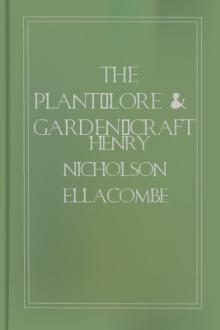The plant-lore & garden-craft of Shakespear, Henry Nicholson Ellacombe [read with me .TXT] 📗

- Author: Henry Nicholson Ellacombe
- Performer: -
Book online «The plant-lore & garden-craft of Shakespear, Henry Nicholson Ellacombe [read with me .TXT] 📗». Author Henry Nicholson Ellacombe
Georgica, ii, 103.
And now the number must far exceed those of Virgil's time. "The cultivated varieties are extremely numerous; Count Odart says that he will not deny that there may exist throughout the world 700 or 800, perhaps even 1,000 varieties; but not a third of these have any value."—Darwin. These are the Grapes that are grown in our hothouses; some also of a fine quality are produced in favourable years out-of-doors. There are also a few which are grown as ornamental shrubs. The Parsley-leaved Vine (Vitis laciniosa) is one that has been grown in England, certainly since the time of Shakespeare, for its pretty foliage, its fruit being small and few; but it makes a pretty covering to a wall or trellis. The small Variegated Vine (Vitis or Cissus heterophyllus variegatus) is another very pretty Vine, forming a small bush that may be either trained to a wall or grown as a low rockwork bush; it bears a few Grapes of no value, and is perfectly hardy. Besides these there are several North American species, which have handsome foliage, and are very hardy, of which the Vitis riparia or Vigne des Battures is a desirable tree, as "the flowers have an exquisitely fine smell, somewhat resembling that of Mignonnette."—Don. I mention this particularly, because in all the old authors great stress is laid on the sweetness of the Vine in all its parts, a point of excellence in it which is now generally overlooked. Lord Bacon reckons "Vine flowers" among the "things of beauty in season" in May and June, and reckons among the most sweet-scented flowers, next to Musk Roses and Strawberry leaves dying, "the flower of the Vines; it is a little dust, like the dust of a bent, which grows among the duster in the first coming forth." And Chaucer says: "Scorners faren like the foul toode, that may noughte endure the soote smel of the Vine roote when it flourisheth."—The Persones Tale.
Nor must we dismiss the Vine without a few words respecting its sacred associations, for it is very much owing to these associations that it has been so endeared to our forefathers and ourselves. Having its native home in the East, it enters largely into the history and imagery of the Bible. There is no plant so often mentioned in the Bible, and always with honour, till the honour culminates in the great similitude, in which our Lord chose the Vine as the one only plant to which He condescended to compare Himself—"I am the true Vine!" No wonder that a plant so honoured should ever have been the symbol of joy and plenty, of national peace and domestic happiness.
FOOTNOTES:[301:1] According to Vopiscus, England is indebted to the Emperor Probus (a.d. 276-282) for the Vine: "Gallis omnibus et Britannis et Hispanis hinc permisit ut vites haberent, et Vinum conficerent."
[302:1] At Stonehouse "there are two arpens of Vineyard."—Domesday Book, quoted by Rudder. Also "the Vineyard" was the residence of the Abbots of Gloucester. It was at St. Mary de Lode near Gloucester, and "the Vineyard and Park were given to the Bishopric of Gloucester at its foundation and again confirmed 6th Edward VI."—Rudder.
[303:1] "Edinburgh Review," April, 1860.
[303:2] See Preface to "Palladius on Husbandrie," p. viii. (Early English Text Society), for a further account of old English Vineyards.
[303:3] For a very interesting account of the formation of lynches, and their connection with the ancient communal cultivation of the soil see Seebohm's "English Village Community," p. 5.
[304:1] On this Vineyard Mr. Skrine, the present owner of Claverton, has kindly informed me that it was sold in 1701 by Mr. Richard Holder for £21,367, of which £28 was for "four hogsheads of wine of the Vineyards of Claverton."
[304:2] Andrew Boorde was evidently a lover of good wine, and his account is: "This I do say that all the kingdoms of the world have not so many sundry kindes of wine as we in England, and yet there is nothing to make of."—Breviary of Health, 1598.
VIOLETS. (1) Queen. The Violets, Cowslips, and the Primroses,Bear to my closet. Cymbeline, act i, sc. 5 (83). (2) Angelo. It is I,
That, lying by the Violet in the sun,
Do as the carrion does, not as the flower,
Corrupt with virtuous season. Measure for Measure, act ii, sc. 2 (165). (3) Oberon. Where Oxlips and the nodding Violet grows. Midsummer Night's Dream, act ii, sc. 1 (250). (4) Salisbury. To gild refined gold, to paint the Lily,
To throw a perfume on the Violet,
To smooth the ice, or add another hue
Unto the rainbow, or with taper-light
To seek the beauteous eye of Heaven to garnish,
Is wasteful and ridiculous excess. King John, act iv, sc. 2 (11). (5) K. Henry. I think the king is but a man, as I am; the
Violet smells to him as it doth to me. Henry V, act iv, sc. 1 (105). (6) Laertes. A Violet in the youth of primy nature,
Forward, not permanent; sweet, not lasting.
The perfume and suppliance of a minute;
No more. Hamlet, act i, sc. 3 (7). (7) Ophelia. I would give you some Violets, but they withered all when my father died. Ibid., act iv, sc. 5 (184). (8) Laertes. Lay her i' the earth,
And from her fair and unpolluted flesh
May Violets spring! Ibid., act v, sc. 1 (261). (9) Belarius. They are as gentle
As zephyrs blowing below the Violet,
Not wagging his sweet head. Cymbeline, act iv, sc. 2 (171). (10) Duke. That strain again! It had a dying fall:
O, it came o'er my ear like the sweet sound,
That breathes upon a bank of Violets,
Stealing and giving odour! Twelfth Night, act i, sc. 1 (4). (11) Song of Spring. When Daisies pied, and Violets blue, &c. Love's Labour's Lost, act v, sc. 2 (904). (See Cuckoo-buds.) (12) Perdita. Violets dim,
But sweeter than the lids of Juno's eyes
Or Cytherea's breath. Winter's Tale, act iv, sc. 4 (120). (13) Duchess. Welcome, my son; Who are the Violets now,
That strew the green lap of the new-come spring? Richard II, act v, sc. 2 (46). (14) Marina. The yellows, blues,
The purple Violets and Marigolds,
Shall as a carpet hang upon thy grave
While summer-days do last. Pericles, act iv, sc. 1 (16). (15) These blue-veined Violets whereon we lean
Never can blab, nor know not what we mean. Venus and Adonis (125). (16) Who when he lived, his breath and beauty set
Gloss on the Rose, smell to the Violet. Ibid. (936). (17) When I behold the Violet past prime,
And sable curls all silver'd o'er with white, * * * * * Then of thy beauty do I question make,
That thou among the wastes of time must go,
Since sweets and beauties do themselves forsake
And die as fast as they see others grow. Sonnet xii. (18) The forward Violet thus did I chide:
"Sweet thief, whence didst thou steal thy sweet that smells,
If not from my love's breath? The purple pride
Which on thy soft cheek for complexion dwells
In my love's veins thou hast too grossly died." Ibid. xcix.
There are about a hundred different species of Violets, of which there are five species in England, and a few sub-species. One of these is the Viola tricolor, from which is descended the Pansy, or Love-in-Idleness (see Pansy). But in all the passages in which Shakespeare names the Violet, he alludes to the purple sweet-scented Violet, of which he was evidently very fond, and which is said to be very abundant in the neighbourhood of Stratford-on-Avon. For all the eighteen passages tell of some point of beauty or sweetness that attracted him. And so it is with all the poets from Chaucer downwards—the Violet is noticed by all, and by all with affectation. I need only mention two of the greatest. Milton gave the Violet a chief place in the beauties of the "Blissful Bower" of our first parents in Paradise—
Iris all hues, Roses, and Jessamin
Rear'd high their flourish't heads between, and wrought
Mosaic; underfoot the Violet,
Crocus and Hyacinth with rich inlay
Broidered the ground, more coloured than with stone
Of costliest emblem;"
Paradise Lost, book iv.
and Sir Walter Scott crowns it as the queen of wild flowers—
Where Birchen boughs with Hazels mingle,
May boast itself the fairest flower
In glen, in copse, or forest dingle."
Yet favourite though it ever has been, it has no English name. Violet is the diminutive form of the Latin Viola, which again is the Latin form of the Greek ἴον. In the old Vocabularies Viola frequently occurs, and with the following various translations:—"Ban-wyrt," i.e., Bone-wort (eleventh century Vocabulary); "Clœfre," i.e., Clover (eleventh century Vocabulary); "Violé, Appel-leaf" (thirteenth century Vocabulary);[310:1] "Wyolet" (fourteenth century Vocabulary); "Vyolytte" (fifteenth century Nominale); "Violetta, Ace, a Violet" (fifteenth century Pictorial Vocabulary); and "Viola Cleafre, Ban-vyrt" (Durham Glossary). It is also mentioned in the Anglo-Saxon translation of the Herbarium of Apuleius in the tenth century as "the Herb Viola purpurea; (1) for new wounds and eke for old; (2) for hardness of the maw" (Cockayne's translation). In this last example it is most probable that our sweet-scented Violet is the plant meant, but in some of the other cases it is quite certain that some other plant is meant, and perhaps in all. For Violet was a name given very loosely to many plants, so that Laurembergius says: "Vox Violæ distinctissimis floribus communis est. Videntur mihi antiqui suaveolentes quosque flores generatim Violas appellasse, cujuscunque etiam forent generis quasi vi oleant."—Apparat. Plant., 1632. This confusion seems to have arisen in a very simple way. Theophrastus described the Leucojum, which was either the Snowdrop or the spring Snowflake, as the earliest-flowering plant; Pliny literally translated Leucojum into Alba Viola. All the earlier writers on natural history were in the habit of taking Pliny for their guide, and so they translated his Viola by any early-flowering plant that most took their fancy. Even as late as 1693, Samuel Gilbert, in "The Florists' Vade Mecum," under the head of Violets, only describes "the lesser early bulbous Violet, a common flower yet not to be wasted, because when none other appears that does, though in the snow, whence called Snowflower or Snowdrop;" and I think that even later instances may be found.
When I say that there is no genuine English name for the Violet, I ought, perhaps, to mention that one name has been attributed to it, but I do not think that it is more than a clever guess. "The commentators on Shakespeare have been much puzzled by the epithet 'happy lowlie down,' applied to the man of humble station in "Henry IV.," and have proposed to read 'lowly clown,' or to divide the phrase into 'low lie down,' but the following lines from Browne clearly prove 'lowly down' to be the correct term, for he uses it in precisely the same sense—
Salutes the gay nymphs as they trimly pass.'
Poet's Pleasaunce."
This may prove that Browne called the Violet a Lowly-down, but it certainly does not prove that name to have been a common name for the Violet. It was, however, the character of lowliness combined with sweetness that gave the charm





Comments (0)